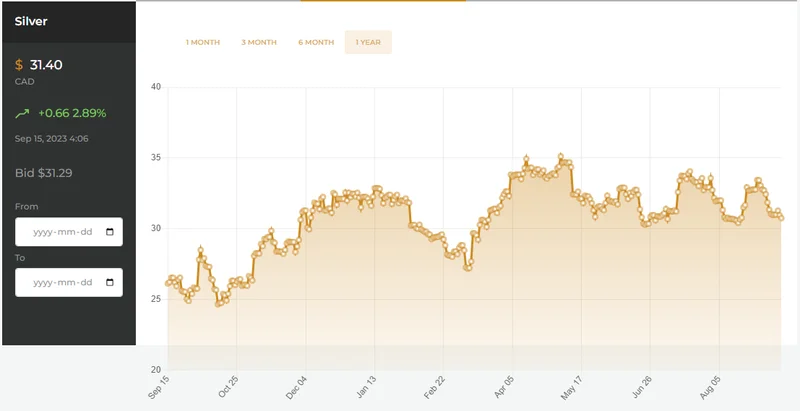Silver Spot Price Rally: What's Driving It and Inventory Tightness
Generated Title: Silver's "Hyperbolic Trajectory": Hype or Reality? A Data-Driven Dive
The Curious Case of Silver's Ascent
Silver's been on a tear lately. Early November 2025 saw the spot price of silver climb yet again, continuing a rally that's been building for weeks. The narrative? A perfect storm of industrial demand, safe-haven investing, and dollar volatility. But let's pump the brakes for a second and look at the numbers, because narratives can be… persuasive.
The FX Empire piece highlights uncertainty as a key driver. Geopolitical tensions, downward revisions to global growth—all the usual suspects pushing investors toward so-called safe havens. Silver, with its lower price point compared to gold, supposedly becomes more accessible to retail investors. But accessible doesn't equal sound. Are these investors really moving the needle, or are we seeing institutional plays masked by a retail narrative?
Then there's the industrial demand angle. Solar panels, electronics, medical devices—silver is supposedly indispensable. And it's true, silver's unique properties make it essential in many applications. But how essential? And how much of this demand is already priced in? We need specifics, not just vague pronouncements about "rising demand."
The most eye-catching claim comes from the second source: a "$0.30 premium over spot" for silver futures, signaling "severe inventory tightness." This, apparently, is not just a fluctuation, but a "structural imbalance." The claim is that buyers are paying extra for immediate metal (backwardation), indicating physical inventories are under acute stress. Historically, this has occurred during aggressive bull markets. The author proclaims that the inversion acts as the “spark” that ignites a synchronized cycle convergence, transforming a bullish trend into a hyperbolic trajectory. Silver Premium Over Spot Confirms Severe Inventory Tightness Beneath the Surface
Digging Deeper: Cracks in the Narrative?
Let's unpack this "hyperbolic trajectory." The author cites cycle convergence, specifically the 30, 60, 90, and 360-day cycles all pointing upwards. Okay, cycles exist (economic cycles are a real thing, obviously). But aligning them perfectly? That sounds a little too neat. My analysis suggests that relying solely on cyclical patterns without considering real-world supply and demand dynamics is a risky game.

And this is the part of the analysis I find genuinely puzzling. The third source, a Kitco News article, throws a wrench in the works. Daniel Ghali at TD Securities warns that silver remains vulnerable to correction because supply chain constraints have eased. He estimates 198 million ounces of silver available in London vaults, reflecting an "epic 111 million ounces added to the free float" shortly after a supposed silver squeeze. Silver rally resumes, but TD warns that increased supply makes the market vulnerable
So, which is it? Severe inventory tightness or an "epic" increase in available silver? A discrepancy of 111 million ounces is not exactly a rounding error. Ghali suggests increased recycling and metal flowing in from other markets (New York, China) might explain the surge. He also points out that "private vaults and scrap" contributed a significant portion. (That is, metal returning to the system from other sources.)
Here's where we need to be critical of the data itself. How accurate are these inventory estimates? Are we comparing apples to apples? The LBMA data is valuable, but it's not a perfect snapshot of global silver supply. There are always hidden stockpiles and unreported sources. (Parenthetical clarification: The accuracy of inventory reporting is always a challenge.)
The TD Securities piece also mentions silver being added to the U.S. Geological Survey's 2025 List of Critical Minerals. The claim is that this "could boost silver's industrial consumption." Maybe. But critical mineral status doesn't automatically translate to increased demand. It might lead to subsidies or preferential treatment, but the actual impact on consumption is far from guaranteed.
It seems as though the so-called silver flood may have been exacerbated by a reshuffling of precious metals. Our estimates of free-floating inventories as of October point to metal returning to the system from other sources than can be explained by withdrawals from COMEX, SHFE, and ETF holdings alone. Private vaults and scrap may have contributed about 30% of the monthly repletion in the LBMA's free float.
A Reality Check
The "hyperbolic trajectory" narrative is compelling, but the data is… conflicted. One source screams shortage, another whispers of a glut. The truth, as always, probably lies somewhere in between. Silver is volatile. It's an investment asset and an industrial commodity. It is dangerous to extrapolate short-term price movements into long-term certainties. Caveat emptor.
-

Warren Buffett's OXY Stock Play: The Latest Drama, Buffett's Angle, and Why You Shouldn't Believe the Hype
Solet'sgetthisstraight.Occide...
-

The Great Up-Leveling: What's Happening Now and How We Step Up
Haveyoueverfeltlikeyou'redri...
-

The Business of Plasma Donation: How the Process Works and Who the Key Players Are
Theterm"plasma"suffersfromas...
-

The Future of Auto Parts: How to Find Any Part Instantly and What Comes Next
Walkintoany`autoparts`store—a...
-

Zcash's Zombie Rally: The Price Prediction vs. What Reddit Is Saying
So,Zcashismovingagain.Mytime...
- Search
- Recently Published
-
- CRWV Stock's Wild Ride: What's Fueling the Volatility and What Analysts Expect
- Netflix Stock Split: What's the Deal and Why Should I Care?
- Google Stock Price: What's Driving Today's Fluctuations?
- QUBT Stock Soars: Earnings Beat and Production Roadmap – What We Know
- CRWV Stock: Rally Hits a Wall—What Analysts Expect and Why You Shouldn't Care
- Nvidia Stock Price: What's Driving the Hype Train and Will it Crash?
- Dairy Queen Rival's Bankruptcy Filing: What Happened and Freddy's Frozen Custard's Role
- Murder Conviction Tossed, Now He's Chief: What Happened and the Fallout
- Switzerland: Tariffs, Trade Deals, and What It All Means
- MetaMask's Chrome Surge: What's Fueling the Adoption?
- Tag list
-
- Blockchain (11)
- Decentralization (5)
- Smart Contracts (4)
- Cryptocurrency (26)
- DeFi (5)
- Bitcoin (30)
- Trump (5)
- Ethereum (8)
- Pudgy Penguins (6)
- NFT (5)
- Solana (5)
- cryptocurrency (6)
- XRP (3)
- Airdrop (3)
- MicroStrategy (3)
- Stablecoin (3)
- Digital Assets (3)
- bitcoin (3)
- PENGU (3)
- Plasma (5)
- Zcash (6)
- Aster (4)
- investment advisor (4)
- crypto exchange binance (3)
- SX Network (3)
